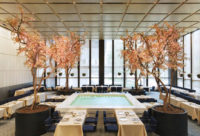Park Avenue Restaurant
AvroKO's designs for the restaurant Park Avenue are as ephemeral as the seasons.
Architects & Firms
New York, New York
AvroKO’s meteoric rise to fame is the stuff of design-industry lore. Headed by former college chums Kristina O’Neal, Greg Bradshaw, William Harris, and Adam Farmerie, the multidisciplinary collaborative has a reputation for both innovation and utter fearlessness. Hungry for a big project when they launched the firm in 2000, the four partners took matters in hand by designing, building, and operating the restaurant Public in Manhattan’s NoHo neighborhood. After that hot spot’s elegantly hip interior garnered a coveted James Beard Award, the firm had little trouble landing plumb commissions, and has gone on to mastermind myriad stylish eateries, residential apartments, and hotels.
Success and critical hosannas haven’t dulled AvroKO’s intrepidity, nor its fervent embrace of seemingly off-the-wall ideas. A case in point is the firm’s scheme for the New York City dining establishment known alternately as Park Avenue Summer, Park Avenue Autumn, Park Avenue Winter, or its current incarnation, Park Avenue Spring. The name, along with the menu, finishes, lighting scheme, and configuration of the 1,100-square-foot main dining room depends on the month.
Summer’s lemon-yellow lacquer walls segue into autumn’s walnut-veneer panels inset with pinstripes of mirror. Winter’s classically styled chandeliers—actually glass bowls filled with crystals—switch to spring’s wood-and-mesh pendant lights. Even the ceiling plane morphs from coffered plasterwork to cork-lined barrel vaulting. The only features that remain untouched are the original terrazzo floor, a private event room clad in wood planks salvaged from old barns, and the 130-guest head count.
This almost comical conceit was hatched by owners Michael and Allen Stillman, with whom AvroKO had collaborated on the industrial-chic steak house Quality Meats. “The Stillmans approached us with the four-seasons idea, changing the design every three months,” O’Neal explains. “For us, the key was avoiding gimmickry.” They did so by devising a literary hook, taking seasonal inspiration from Captain James Cook’s 18th- century explorations. Park Avenue Summer references voyages to the Sandwich Islands, Autumn sets sail to the Pacific Northwest, Winter channels the icy-cool Arctic Circle, and Spring, which completes the seasonal cycle, is a rangy Oceanic forest. “It’s a wild, lush New Zealand landscape with an English-garden twist,” O’Neal says of the Spring design.
Dining in the restaurant, you don’t notice the presto-change-o aspect unless you really look for it. The coffered plasterwork ceiling of wintertime certainly looks permanent. Such illusions belie the effort that goes into each makeover, a two-day process requiring 12 people. “It works like a stage set,” O’Neal explains. Banquette cushions flip to reveal a second fabric, snap-on chair covers reverse, and last season’s interlocking, steel-framed wall panels slide down 3-inch-wide cold-rolled-steel tracks to be removed for safekeeping in a Queens storage facility. Adding an extra dimension, a series of niches lining the south side is covered during some seasons and exposed the next. Spring’s 4-by-6-foot brass screens, for instance, alternate with recesses lined in patinated-bronze paper and perked up with antique stone garden pots.
If this all sounds like a lot of work, it is. “We have to reengineer the space each time, and even do small renovations,” says O’Neal. “During the Autumn installation, we had to re-create the entire ceiling because we’d designed a series of rope installations that proved too heavy.” Adding to the challenge, AvroKO is known for eleventh-hour tweaks. Although the designers established each season’s direction and color palette well in advance, materials and details were finalized only a few weeks prior to installation, with many items bespoke. The Autumn scheme, illuminated by metalized polycarbonate Tom Dixon globes, is the only season without custom lighting, for example. Spring’s floral arrangements, an ever-changing mix of exotic purple blooms, proved particularly bedeviling. “We always use flowers to divide the room, so it becomes a part of the architecture rather than just plant life,” O’Neal explains. Despite trekking to the flower market with the florist, it still took a few nights to get the blossoming partitions just right.
Although AvroKO has incorporated dynamic elements in previous projects—notably Smart.Space, an experimental loft concept with movable kitchen walls and Murphy beds—the Park Avenue project upped the ante. “With restaurants, we’re always thinking about how to transform a finite space for events,” says O’Neal, “but this was a whole new level. Like a traveling show, it has to break down fast, and all the parts have to pack and ship easily without breaking.” And don’t forget clearly marking components for reinstallation in nine months.
The flip side is that the design itself is treated not at all preciously. “Because it’s so temporary, Park Avenue is more playful and whimsical than what we’ve done in the past.” A change indeed.



